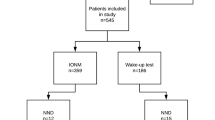Abstract
Study Design
Retrospective.
Objectives
The purpose of this study is to review the efficacy of monitoring data and outcomes in pediatric patients with spinal cord pathology.
Summary of Background Data
The incidence of spinal cord pathology in pediatric patients with scoliosis has been reported between 3% and 20%. Previous studies demonstrated that intraoperative spinal cord monitoring (IOM) during scoliosis surgery can be reliable despite underlying pathology.
Methods
A single-center retrospective review of 119 spinal surgery procedures in 82 patients with spinal cord pathology was performed. Diagnoses included Arnold-Chiari malformation, syringomyelia, myelomeningocele, spinal cord tumor, tethered cord, and diastematomyelia. Baseline neurologic function and history of prior neurosurgical intervention were identified. Outcome measures included ability to obtain reliable monitoring data during surgery and presence of postoperative neurologic deficits. Results were compared for 82 patients with adolescent idiopathic scoliosis (AIS).
Results
Usable IOM data were obtained in 82% of cases (97/119). Twenty-two cases (18%) had no lower extremity data. Patients with Arnold-Chiari malformation or syringomyelia pathologies, in isolation or together, had a significantly higher rate of reliable data compared to other pathologies (p!.0001). Among study group cases with usable data, there were 1 false negative (1%) and 4 true positive (4%) outcomes. There were no permanent neurologic deficits. The spinal cord pathology group demonstrated 80% sensitivity and 92% specificity.
Conclusions
Spinal cord monitoring is a valuable tool in pediatric patients with spinal cord pathology undergoing spinal deformity surgeries. When obtained, data allow to detect changes in spinal cord function. Patients with a diagnosis of Arnold-Chiari or syringomyelia have monitoring data similar to those patients with AIS. Patients with other spinal cord pathologies have less reliable data, and surgeons should have a lower threshold for performing wake-up tests to assess spinal cord function intraoperatively.
Similar content being viewed by others
References
Gupta P, Lenke LG, Bridwell KH. Incidence of neural axis abnormalities in infantile and juvenile patients with spinal deformity. Is a magnetic resonance image screening necessary? Spine 1998;23: 206–10.
Winter RB, Lonstein JE, Heithoff KB, Kirkham JA. Magnetic resonance imaging evaluation of the adolescent patient with idiopathic scoliosis before spinal instrumentation and fusion. A prospective, double-blinded study of 140 patients. Spine 1997;22:855–8.
Inoue M, Minami S, Nakata Y, et al. Preoperative MRI analysis of patients with idiopathic scoliosis: a prospective study. Spine 2005;30:108–14.
Dobbs MB, Lenke LG, Szymanski DA, et al. Prevalence of neural axis abnormalities in patients with infantile idiopathic scoliosis. J Bone Joint Surg Am 2002;84-A:2230–4.
Pahys JM, Samdani AF, Betz RR. Intraspinal anomalies in infantile idiopathic scoliosis: prevalence and role of magnetic resonance imaging. Spine 2009;34:E434–8.
Cardoso M, Keating RF. Neurosurgical management of spinal dysra- phism and neurogenic scoliosis. Spine 2009;34:1775–82.
Lew SM, Kothbauer KF. Tethered cord syndrome: an updated review. Pediatr Neurosurg 2007;43:236–48.
Zadeh HG, Sakka SA, Powell MP, Mehta MH. Absent superficial abdominal reflexes in children with scoliosis. An early indicator of syringomyelia. J Bone Joint Surg Br 1995;77:762–7.
Adzick NS, Walsh DS. Myelomeningocele: prenatal diagnosis, pathophysiology and management. Semin Pediatr Surg 2003;12:168–74.
Wilson-Holden TJ, Padberg AM, Lenke LG, et al. Efficacy of intraoperative monitoring for pediatric patients with spinal cord pathology undergoing spinal deformity surgery. Spine 1999;24:1685–92.
Nuwer MR, Dawson EG, Carlson LG, et al. Somatosensory evoked potential spinal cord monitoring reduces neurologic deficits after scoliosis surgery: results of a large multicenter survey. Electroencephalogr Clin Neurophysiol 1995;96:6–11.
Sloan TB, Janik D, Jameson L. Multimodality monitoring of the central nervous system using motor-evoked potentials. Curr Opin Anaesthesiol 2008;21:560–4.
Padberg AM, Wilson-Holden TJ, Lenke LG, Bridwell KH. Somatosensory- and motor-evoked potential monitoring without a wake-up test during idiopathic scoliosis surgery. An accepted standard of care. Spine 1998;23:1392–400.
Thuet ED, Winscher JC, Padberg AM, et al. Validity and reliability of intraoperative monitoring in pediatric spinal deformity surgery: a 23-year experience of 3436 surgical cases. Spine 2010; 35:1880–6.
Eule JM, Erickson MA, O’Brien MF, Handler M. Chiari I malformation associated with syringomyelia and scoliosis: a twenty-year review of surgical and nonsurgical treatment in a pediatric population. Spine 2002;27:1451–5.
Kulwin CG, Patel NB, Ackerman LL, et al. Radiographic and clinical outcome of syringomyelia in patients treated for tethered cord syndrome without other significant imaging abnormalities. J Neurosurg Pediatr 2013;11:307–12.
Bowen RE, Abel MF, Arlet V, et al. Outcome assessment in neuromuscular spinal deformity. Journal of pediatric orthopedics 2012;32:792–8.
Nordwall A, Wikkelso C. A late neurologic complication of scoliosis surgery in connection with syringomyelia. Acta Orthop Scand 1979;50:407–10.
SRS Neuromonitoring Information Statement, 2009. http://www.srs.org/professionals/advocacy_and_public_policy/nueromonitoring_information.htm. Accessed June 6, 2014.
Author information
Authors and Affiliations
Corresponding author
Additional information
Study conducted at Washington University School of Medicine, St. Louis Shriners Hospital for Children, and St. Louis Children’s Hospital, St. Louis, Missouri, USA.
Author disclosures: AWA (none); EDT (none); AMP (none); MW (none); SJL (none).
Rights and permissions
About this article
Cite this article
Aleem, A.W., Thuet, E.D., Padberg, A.M. et al. Spinal Cord Monitoring Data in Pediatric Spinal Deformity Patients With Spinal Cord Pathology. Spine Deform 3, 88–94 (2015). https://doi.org/10.1016/j.jspd.2014.06.011
Received:
Revised:
Accepted:
Published:
Issue Date:
DOI: https://doi.org/10.1016/j.jspd.2014.06.011




